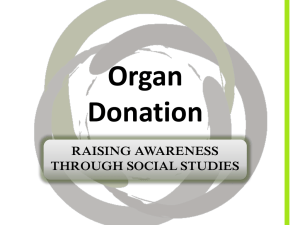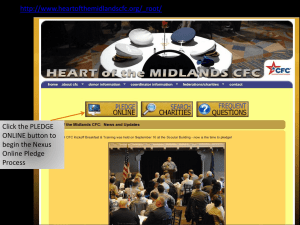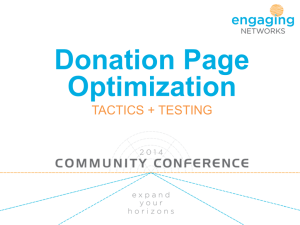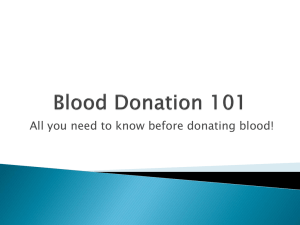Approaching the Families of Potential Organ
advertisement
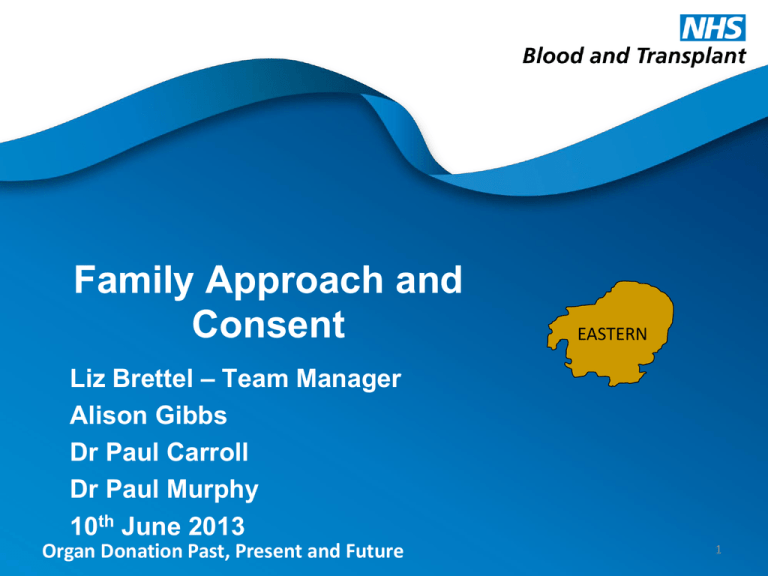
Family Approach and Consent EASTERN Liz Brettel – Team Manager Alison Gibbs Dr Paul Carroll Dr Paul Murphy 10th June 2013 Organ Donation Past, Present and Future 1 EASTERN Organ Donation Past, Present and Future 2 Another family’s story… EASTERN “In 2011, my 16 year-old son Aaron was involved in a road crash, where he sustained fatal head injuries. He was hit at just after 5 pm and his life support machine was turned off at just after midnight. Aaron was a kind and loving child, who had often spoken about organ donation. Obviously we never expected in a million years to be faced with the situation that occurred on that night, but one thing that sticks out in my mind is that we were never asked about donation.” Organ Donation Past, Present and Future 3 Another family’s story… EASTERN “I raise this issue as a pointer to the service for the future. I utterly regret that I was not given the chance to “share” Aaron with someone else, to give life from his death. At the time, I needed someone to raise the issue. I simply didn’t have the fortitude to do so and in the context of difficult decisions that night, the decision to donate organs would have been the easiest of all.” Organ Donation Past, Present and Future 4 Session Objectives EASTERN • Understanding the importance of consent in overall supply of organs for transplantation. • Understanding why families say no. • Why using a 1st person consent model is often unhelpful. • A 3 stage approach – how best to inform and support families through their decision. • Understanding the role of the SNOD in the family approach. Organ Donation Past, Present and Future 5 Regional Data Dr Paul Carroll - CLOD The Ipswich Hospital Organ Donation Past, Present and Future EASTERN 6 Where are potential donors in the Eastern team lost? 3rd EASTERN 5th Conclusion: Are we happy to rest on our laurels? 5th Organ Donation Past, Present and Future 3rd 7 Consent DBD 68% DCD 73% + EASTERN 20% 66% + SNOD = SNOD Doctor (68) (89) (56) (78) Eastern Scotland London South West Doctor 61% (58) UK DBD Doctor 100 92 % approaches where SN-OD involved 80 + EASTERN SNOD 92 91 88 85 83 75 75 75 60 62 58 52 40 20 0 1 April 2012 to 31 March 2013, data as at 4 April 2013 Organ Donation Past, Present and Future Team -------- National rate 9 DCD Doctor % approaches where SN-OD involved 100 + EASTERN SNOD 85 80 80 76 83 80 74 69 65 60 58 53 53 40 37 20 0 Team -------- National rate 1 April 2012 to 31 March 2013, data as at 4 April 2013 Organ Donation Past, Present and Future 10 Approaching the families of potential organ donors Dr Paul Murphy National Clinical Lead for Organ Donation Organ Donation Past, Present and Future 11 Consent / authorisation Outline • Background information – Potential Donor Audit data – Legal framework for consent • NICE Short Clinical Guideline – Family approach • Implementation – NHSBT documents – DVD Organ Donation Past, Present and Future Where donation potential is lost? •We’ve known for years that low consent rates easily accounts for the biggest loss of potentially transplantable organs in the UK. •No other intervention could increase the availability of organs for transplantation to the extent that an increase in consent to 80% would. Organ Donation Past, Present and Future Potential Donor Audit 2011/12 DBD If the UK had a 20% family refusal rate • Additional 120 DBD donors • Additional 280 DCD donors • Additional 1200 transplants Organ Donation Past, Present and Future Family refusal rates 45 40 family refusal rate 35 30 25 20 15 10 5 0 UK Italy Romania Rep Ireland Croatia Organ Donation Past, Present and Future Spain Poland Slovakia Hungary Czech Republic Consent / authorisation rates, 2011-2 UK average (range) 64(54 – 78)% Organ Donation Past, Present and Future 52 (42 - 67)% Legal framework for consent / authorisation • Human Tissue Act 2004 and Human Tissue (Scotland) Act 2006 • Hard opt-in • Role of family – Provide evidence on views of the individual – Assume responsibility for decision making when these views are not known Organ Donation Past, Present and Future Impact of the UK Organ Donor Register? 100 20 consent / authorisation rate (%) DBD DCD 18 80 16 70 67.7% 14 60 58.2% 12 50 10 40 8 30 6 20 4 10 2 0 0 2003/04 2004/05 2005/06 2006/07 2007/08 2008/09 2009/10 2010/11 2011/12 2012/13 year Organ Donation Past, Present and Future registrants (millions) ODR 90 Public support? BBC DoNation Survey August, 2005 Organ Donation Past, Present and Future Why do families say ‘no’? Organ Donation Past, Present and Future The family approach: international evidence • Preparation and time Planning • Acceptance of loss – Clarity of language – Understanding concept of brain death Confirming understanding and • Positive impact of a competent and experienced requestor acceptance of loss • Adverse impact of certain kinds of language – Apologetic – Negative Discussing donation Organ Donation Past, Present and Future Modifiable elements of the family approach Consent / authorisation DBD donation 80 Family consent / aut horisat ion rat e ( %) 75 70 Consent rate when SNOD involved 65 60 Consent rate when SNOD not involved 55 50 45 Organ Donation Past, Present and Future 2 20 11 /1 1 20 10 /1 0 20 09 /1 /9 20 08 /8 20 07 /7 06 20 20 05 /6 40 Consent / authorisation DCD donation 75 70 Consent rate when SNOD involved Family consent / aut horisat ion rat e ( %) 65 60 55 50 45 40 Consent rate when SNOD not involved 35 Organ Donation Past, Present and Future 2 20 11 /1 1 20 10 /1 0 20 09 /1 /9 20 08 /8 20 07 /7 06 20 20 05 /6 30 NICE Guidance 1.1.11 A multidisciplinary team (MDT) should be responsible for planning the approach and discussing organ donation with those close to the patient. 1.1.12 The MDT should include: – the medical and nursing staff involved in the care of the patient, led throughout the process by an identifiable consultant – the specialist nurse for organ donation – local faith representative(s) where relevant. Organ Donation Past, Present and Future NICE Guidance 1.1.14 The [multi-disciplinary team] involved in the initial approach should have the necessary skills and knowledge to provide to those close to the patient appropriate support and accurate information about organ donation. 1.1.30 The [multidisciplinary team] involved in the identification, referral to specialist nurse for organ donation, and consent should have the specialist skills and competencies necessary to deliver the recommended process for organ donation outlined in this guideline. Organ Donation Past, Present and Future Guidance from the GMC UK General Medical Council guidance on end of life care , 2010 81. If a patient is close to death and their views cannot be determined, you should be prepared to explore with those close to them whether they had expressed any views about organ or tissue donation, if donation is likely to be a possibility. 82.You should follow any national procedures for identifying potential organ donors and, in appropriate cases, for notifying the local transplant coordinator. Organ Donation Past, Present and Future Involvement of SNOD in approach to families 80 71 70 involvement of SN-OD in family approach ( %) 63 59 60 51 50 40 DBD DCD 30 20 10 0 Oct 0 9 - Mar 1 0 Organ Donation Past, Present and Future Apr 1 0 - Sep 1 0 Oct 1 0 - Mar 1 1 Apr 1 1 - Mar 1 2 UK Donation Ethics Committee Contact between the clinical team treating the potential donor and the SN-OD before the decision has been made to withdraw life-sustaining treatment is ethically acceptable. Advantages include identifying patients who are not suitable donors, and avoiding distressing delays to the family if the SN-OD has to travel some distance to get to the unit Supporting the family through the discussion about organ donation requires a team approach. The SN-OD has the detailed knowledge and expertise to lead the process, but needs to be supported by other members of the clinical team. Organ Donation Past, Present and Future The family approach: 3 key stages Planning Confirming understanding and acceptance of loss Discussing donation Organ Donation Past, Present and Future As a standard of best practice, the family approach should be a collaborative effort between senior clinical staff and the SN-OD Planning the family approach Planning Establish the team: • Consultant • SN-OD The planning phase is possibly the most important element of the approach. SNODs are very well placed to reinforce the key elements of best practice. Organ Donation Past, Present and Future • Bedside nurse Meet in private Clarify clinical situation Seek evidence of prior consent Planning the family approach Planning Key family members by name Key family issues The specialist nurse can help to identify families who have yet to understand and / or accept the inevitability of their loss. Agree timing and setting, ensuring these are appropriate to family needs Involve others as required, eg faith leaders Organ Donation Past, Present and Future Planning the family approach Planning Although clinical circumstances vary, as a standard SNODs should be involved in planning the family approach and subsequent contact with the family Organ Donation Past, Present and Future Agree a process of approach and who will be involved • how will team members be introduced • who will lead the initial discussion (breaking bad news) • how will the transition to donation be made Planning Planning Clip 2 Good planning.mov Embed Clip 2 Or play from video Title 2, Ch 1 – 04:03 – 07:13 Organ Donation Past, Present and Future Confirming understanding Planning • introducing the SN-OD Confirming understanding and acceptance of loss • assessing understanding − brain-stem death • de-coupling It is vital that staff explicitly consider whether a family have understood and accepted their loss, and are thereby ready to make the transition to donation. Organ Donation Past, Present and Future Introducing the specialist nurse Planning Clip1 introducing SNOD.mov Embed Clip 1 Or play from Video: Title 2, Ch 1 – 11:40 – 12:00 Organ Donation Past, Present and Future Introducing the SN-OD Planning Confirming understanding and acceptance of loss “Mrs Smith, this is Louise Green, she is a specialist nurse that we work with on the unit and who helps support families at this time.” There is no evidence that families recognise a conflict when meeting the SN-OD at this time. Organ Donation Past, Present and Future Confirming understanding Planning • introducing the SN-OD Confirming understanding and acceptance of loss • assessing understanding − brain-stem death • de-coupling It is vital that staff explicitly consider whether a family have understood and accepted their loss, and are thereby ready to make the transition to donation. Organ Donation Past, Present and Future Breaking bad news? Clip 3 Breaking Bad news poor.mov Embed Clip 3 Or play from video Title 2, Ch1 – 08:20 – 10:07 Organ Donation Past, Present and Future Ensuring understanding Clip 4 Breaking bad news good.mov Embed Clip 4 Or play from video Title 2, Ch 1 13:20 – 15:40 Organ Donation Past, Present and Future Assessing understanding Planning Confirming understanding and acceptance of loss “I know you have been through a great deal in the last few days, but can you briefly tell me what your understanding of what the situation is and what has happened to John up until now?” It is often useful to ask a family lead to explain their current understanding of a loved one’s condition. Organ Donation Past, Present and Future De-coupling Planning Confirming understanding and acceptance of loss “I can see that you are finding this really difficult to come to terms with and I am sure you need some time on your own to talk about I’ve just told you. So I will come back a bit later.” Families are hardly likely to consider a post-mortem intervention if they have yet to accept the death of a loved one. Organ Donation Past, Present and Future Discussing donation Planning • making the transition • the implications of prior first person consent Confirming understanding and acceptance of loss • careful use of language − positive vs negative − open vs closed questions Discussing donation Organ Donation Past, Present and Future − anticipation of common concerns Raising donation – not on ODR Clip 5 Transition to SNOD not on ODR.mov Embed Clip 5 Or play from video Title 2, Ch 1 17:58 – 19:38 Organ Donation Past, Present and Future Making the transition Planning Confirming understanding and acceptance of loss Discussing donation Organ Donation Past, Present and Future “I would like to talk to you now about something you might not be expecting, and that is organ donation. Tonight, John has the opportunity to save and transform the lives of several people.” Who mentions ‘donation’ for the first time is less important than when and how it is introduced Discussing donation Planning Confirming understanding and “Louise here has expertise in this area, and I am now going to hand over to her.” acceptance of loss Discussing donation Organ Donation Past, Present and Future Who mentions ‘donation’ for the first time is less important than when and how it is introduced Patient’s wishes are not known Planning “Mrs Smith, do you know whether your husband wanted to be an organ donor when he died?” Confirming understanding and acceptance of loss Discussing donation Organ Donation Past, Present and Future “Mrs Smith, tell me what your husband wanted to happen when he died.” The law passes authority for decision making onto the family when the patient’s wishes are unknown Patient’s wishes are not known Planning X “Mrs Smith, do you know whether your husband wanted to be an organ donor when he died?” Confirming understanding and acceptance of loss Discussing donation Organ Donation Past, Present and Future “Mrs Smith, tell me what your husband wanted to happen when he died.” The law passes authority for decision making onto the family when the patient’s wishes are unknown Consent and the Organ Donor Register Consent rate (%) DBD on ODR 92 DBD not on ODR 56 All DBD 65 DCD on ODR 76 DCD not on ODR 44 All DCD 51 DBD and DCD on ODR 84 DBD and DCD not on ODR 49 All deceased donors 57 Organ Donation Past, Present and Future Registered on ODR Clip 6 Transition to SNOD on ODR.mov Embed Clip 6 Or play from video Title 8 Ch 1 05:50 – 07:21 Organ Donation Past, Present and Future Prior first person consent Planning Confirming understanding and acceptance of loss Discussing donation Organ Donation Past, Present and Future “Mrs Smith, you may not be aware of this but your husband is on the National Organ Donor Register. When he registered with his new GP six years ago he also decided that he wanted be an organ donor after his death.” If a patient is on the Organ Donor Register, then consent has already been given. Prior first person consent Planning Confirming understanding and acceptance of loss Discussing donation Organ Donation Past, Present and Future “What this means is that John has given his consent for donation to take place, and what we would like to do now is explain how we can respect his decision.” There is no provision in law for families to overturn the wishes of the patient. Summary • Identify and refer as soon as possible • Explicitly consider the three stages of the family approach • Do not raise donation until a family have understood and accepted their loss • Present donation in a positive way • Act upon prior first person consent • Avoid exclusive focus on the wishes of the individual Organ Donation Past, Present and Future



